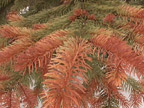Disorders
(Abiotic)
|
| 
|
Chlorosis
A
tree that chronically has off-color, pale, or yellow leaves is
described as chlorotic. This is often caused when a specific nutrient
is deficient or unavailable. See
fertilization... |
|
 |
Water Stress
Periods
of a prolonged drought or excessive moisture can create water
stess. The symptoms include wilting in the top of the crown and
can lead to a decline in health. Learn
how to help your trees recover from water/drought stress. |
|
 |
Herbicide Damage (drift)
Symptoms
vary depending on the type and concentration of herbicide. Symptoms
include brown, curled, or distorted foliage, especially on the
margins of leaves. |
|
 |
Salt Damage
The
accumulation of de-icing salt in the soil and on foliage can kill
new growth. Clusters of thin shoots result in an appearance called
a "witch's broom." |
|
 |
Animal Damage
Rabbits,
squirrels and deer commonly feed on the bark of certain species
for nutrition in the winter. |
|
 |
Winter Damage
Lack
of snow and abnormal temperatures can often cause winter injury
in conifers. Browning and loss of needles are common symptoms. |
|
 |
Included Bark
Technically
a structural disorder that can lead to stem failure. Structural
pruning can help reduce this chance of failure. |
|
| |

